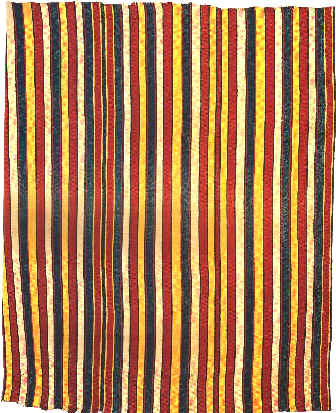
|
One of the most important tribes in North East of Iran, whose majority are Turkish and a minority of Kurd, Tajik origin. Some of them are residing among Bakhtiari clan and a group in Khamseh (Fars) and partly reside in Khorasan, one of their most well-known weaving is kilims of Shahseven. In all Shahseven kilims, one may find big, brocading motif in a line or a row; big motives are four in each band, forming a starry design. Shahsevens are the main weavers of handbag and traveling bag; these products are woven by every Iranian clan except in the regions of Turkmen, Baluch and residents of other oriental frontiers. In handbags of Shahseven one may find spiral weaving, animal features, birds, flowers and stars which are sometimes slit like kilims. Shahseven’s silique (khorjin) are very small with a very fine and marvelous texture. Shahseven tribes are divided into a few groups regarding to their living territories: Moghan Shahsevens Moghan is the greatest clan of shahseven, living in Moghan Plain. Kilim of Moghan Shahseven has the most traditional designs, with a harmony in design, texture and color. Some kilims have ribbons with a uniform weaving and no limit in color. Other specifications of these kilims are: Ground design: Wide horizontal ribbon with Turkish motives and narrow ribbons with geometric motives among wide ribbons Margins: Narrow Size and feature: Narrow and long Material: Warps with natural brown wool, wefts of soft wool Texture: Strong slit, rows of twining wefts among ribbons Color: Dark red, green, brown, milky white Fringes: Uniform, network, sometimes with uniform diagonal in the backside Selvages: Extra braiding or uniform Motives of big stars, Turkish or spider-like features with a different weaving are most used. Shahseven of Hashtrud Ground design: wide horizontal ribbons with Turkish motives and ribbons together with geometric motives Margins: Narrow Size and feature: Narrow and Long Materials: Warps of loose and thick wool; wefts of tough and coarse wool Texture: Loose slit weaving Colors: Quiet colors such as pink, light green, dark blue and brown Fringes: uniform, Twill weaving, with panel and knots, plain Selvages: supplementary rope weaving, uniform (under influenece of Kurd neighbors in weaving method of kilims) Shahseven of Mianeh Miyaneh and Hashtrud are close to each other and Shahsevens of Mianeh and Hashtrud have migrated in the same time and are mixed together; but kilims of Miyaneh Shahseven are larger than Hashtrud’s; also designs of traditional ribbon and crenated big medallions are a purticular of its motives. Warps of kilim are usually of wool or yarn, self colored ropes could be seen on the background specifications of the region’s kilim are: Ground design: Shahseven ribbon design, large crenated medallions Margins: Narrow Size and feature: Large and rectanguler Materials: Woollen warps (sometimes yarn), weft of wool and yarn Texture: Fine slittweaving and weft wrapping panel lines Colors: Cherry red, orange, yellow, light blue Fringes: Miscellaneous Selvages: Miscellaneous, mostly with parallel weaving Shahseven of Bijar This group has a large activity in weaving kilim and bags; they ofter interesting innovations in combination, coloring and designing their hand-woven. Many motives featured in Shahseven kilims are a gift of other regions, so distinguishing their identity is rather hard. Specifications of Shahseven kilim are: Ground design: Similar to kilims of Moghan Size and feature: Mostly long and narrow Material: Wool, Sometimes cotton warps Texture: Slit weaving, sometimes weft-faced designs, together with weft-twining Colors: Soft light orange, yellow, light brown, blue, pink in miscellaneous Fringes: Various Selvage: Usually uniform Shahseven of Khamseh This region is different than Khamseh tribe of Fars province. These people are living near Zanjan and their kilims are fine, using the method of strong-slit and connected. Ground Design: Quite similar to kilims of Moghan Size and feature: Usually long and narrow Materials: Coarse wool, strong weaving, limited use of yarn warps Texture: Fine slit weaving, sometimes dovetailing weaving Colors: Dark colors such as dark brown, blue and red Fringes: Various Selvages: Usually uniform Shahseven of Qazvin In the region, though, kilim is woven in abundance and its kinds are a little different than other Shahseven works; some small groups make their design similar to kilims of Khamseh. Ground design: Unlimitedly under influence of other tribes, some designs are similar to Moghan and Khamseh. Size and feature: Narrow and long Material: Woolen warps, woolen coarse wefts, limited use of yarn warps Texture: Slit weaving, fine, dovetailing Colors: Except for dark yellow, all colors are dark Fringes: Various Selvages: Normally uniform Shahseven of Saveh They have still reserved their tribal life and their hand-woven have reserved their special designs and special types. Yarn warps and slits connected weaving results coarseness of these hand-made as a specialty of the regions kilims. Ground design: Under influence of other tribe Size and Feature: Narrow and long Materials: Yarn warps, coarse wool weft Texture: Strong slit weaving, dovetailing Colors: Limited and mostly dark Fringes: Uniform twill weaving at the backside of kilim Selvages: Reinforced by supplementary ropes Shahseven of Varamin Varamin is one of the most important centers of kilim weaving and has much variety in its textiles. Kilim of this region is usually rectangular with strong selvage. Its knotted fringes, usually, are woven in foursome groups. Ground Design: Various, ribbon like and traditional designs appropriated to North West of Iran Size and Feature: Rectangular Material: Wool warps, sometimes yarn Texture: Fine slit weaving, connected interlock, rows with weft faced design, tablet Weaving: wide panel ribbons with uniform weaving Color: Miscellaneous Fringes: Knotted in foursome groups Selvages: Reinforced by supplementary ropes 

Silk; 106x126 cm.; 19th century
Hashtrud: 320x195 cm.
Hashtrud: 345X152 cm.
Mianeh: 137X106 cm
|
© Copyright Caroun.com. All rights reserved.